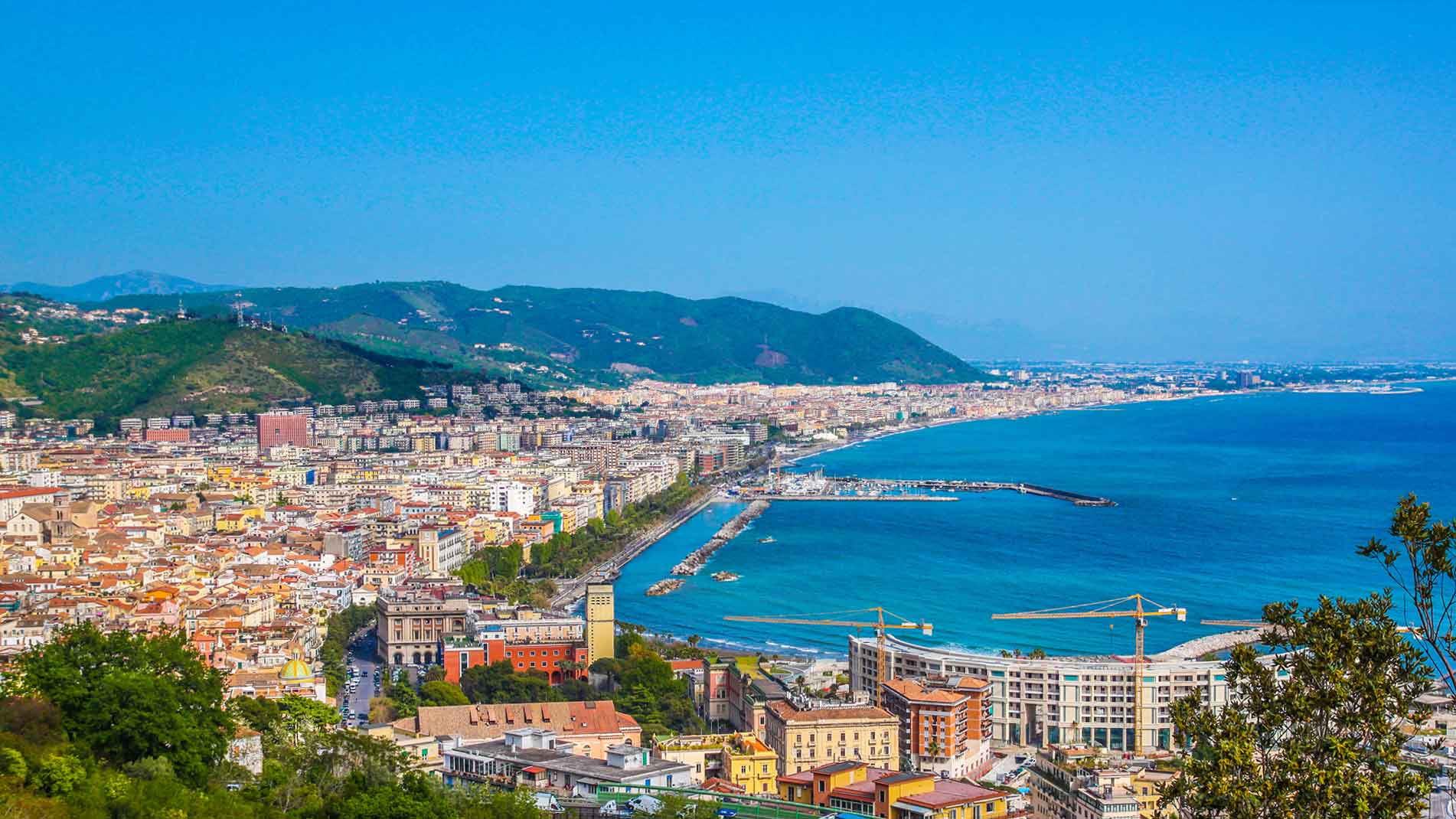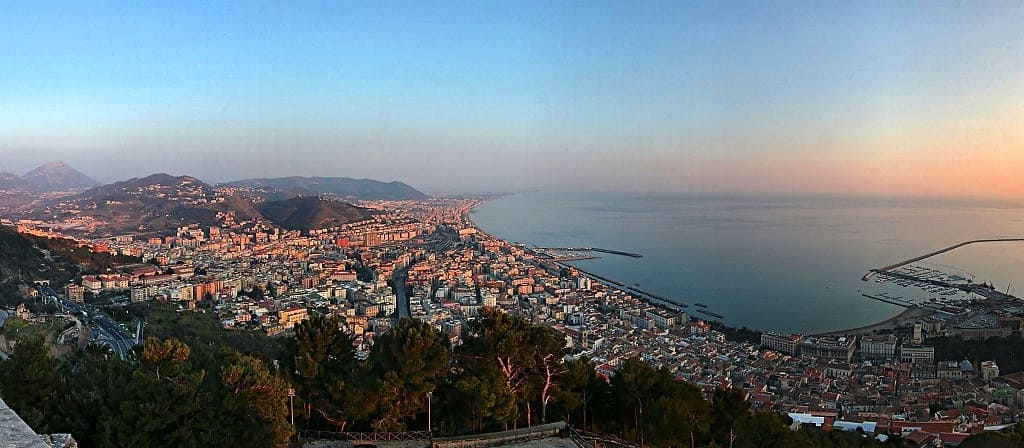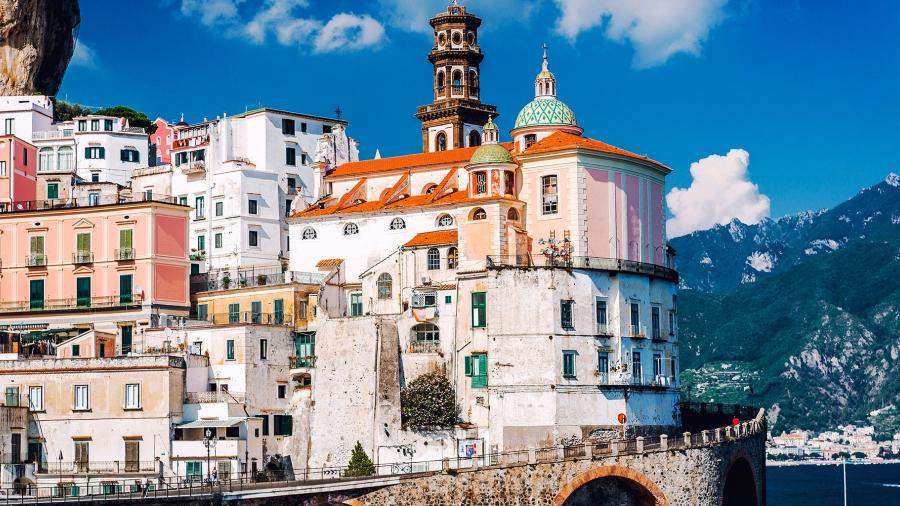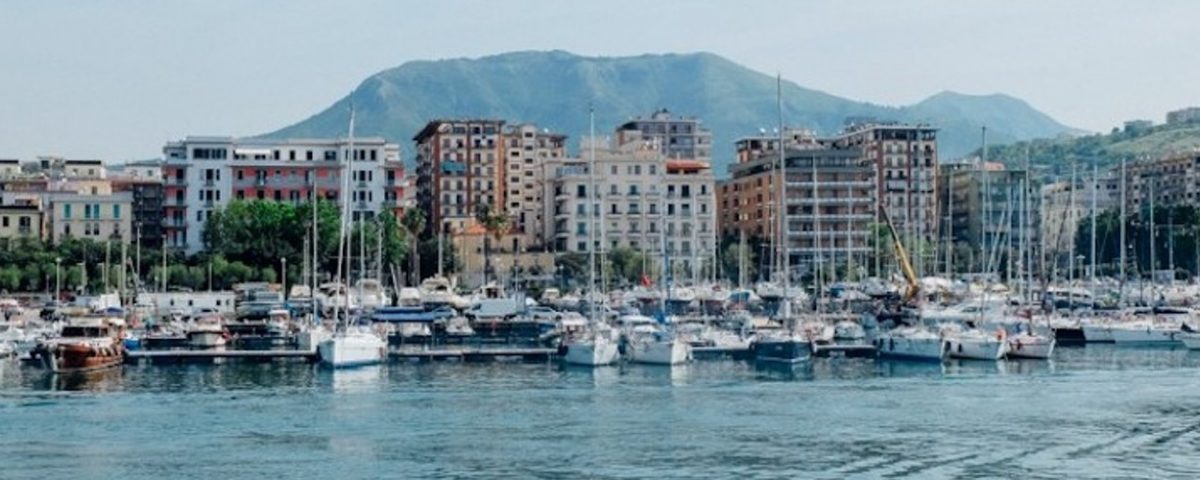



Salerno during the Middle Ages lived under the Lombard domination, one of the most important historical phases, having been the capital of the Principality of Salerno, a territory that gradually came to include a large part of the Italian continental South.
Salerno is home to the Salerno Medical School, which was the first and most important medical institution in Europe at the beginning of the Middle Ages and as such is considered by many to be a forerunner of modern universities.

In 1419 for financial necessities Giovanna II ceded the city as a fief to the Colonna, and then passed to the Orsini and finally to the Sanseverino, a powerful feudal family that had a lot of influence on the fate of the Kingdom of Naples for much of the Renaissance. Under the Sanseverinos the city experienced decades of intense cultural life: Masuccio Salernitano was secretary of the first prince of the dynasty, Bernardo Tasso was a trusted advisor to Ferrante and the medical school had new impetus and splendor, thanks to the presence of illustrious personalities such as Scipione Capece, Agostino Nifo and the Martelli brothers. With the fall of Ferrante Sanseverino, in 1578 the city was given as a fief by the king to Nicola Grimaldi and only in 1590 was he able to redeem himself by paying a sum of money. The revolution against the Spanish rulers in 1647 also had repercussions in Salerno on the model of what happened in Naples with Masaniello, there was a popular movement led by the fishmonger Ippolito di Pastina. In the following years the city was hit by several dramatic events that considerably reduced the population of the city: in 1656 there was an epidemic of plague and on 5 June 1688 it suffered a violent earthquake, followed by a new one in 1694.

It took decades for the fate of Salerno to recover from these fatal events. At the beginning of the eighteenth century the city was reduced to a small town of a few thousand inhabitants and only in the second half of the eighteenth century, with the arrival of the Enlightenment, was there a period of partial rebirth. In 1799 the city joined the Neapolitan Republic with the Ruggi d'Aragona brothers, who established a provisional government and headed the Sele department.

In the first half of the nineteenth century, during the Bourbon reign, the first industries were born in Salerno, mostly with foreign capital (Swiss in particular). Salerno gave support to Garibaldi in 1860 with nine Salerno people who were in the "Thousand" and there were numerous affiliations to secret societies, such as the Carboneria.

In 1861, the year of unification, Salerno was the third Italian province for added value per capita: in 1877 there were 21 textile factories on the territory with about 10,000 workers, and Salerno was nicknamed "the Manchester of the Two Sicilies".

From February to August 1944 Salerno was the seat of the Italian government, hosting the Badoglio I, Badoglio II and Bonomi II governments that led to the Salerno turnaround.
To give a term of comparison, just think that in the same period in Turin only 4,000 workers worked in this sector. After the unification, numerous industries collapsed, including the once flourishing paper mills.
In September 1943, during the Second World War, the city (and the coast of its gulf, up to Agropoli) was the scene of the so-called landing of Salerno: with this operation the allies accessed the Tyrrhenian coast of the Italian peninsula and opened the way to advance towards Rome. In the period that followed the landing (from February 1944) the city hosted the first governments of post-fascist Italy and the fleeing royal family, becoming the capital of Italy until the liberation of Rome (early June 1944). At this juncture there was the so-called Turn of Salerno, with which the anti-fascists, the monarchy and Badoglio found a compromise for a government of national unity.

In 1954 the city was hit by a strong flood that caused hundreds of deaths and in 1980 it was also affected by the earthquake that hit Irpinia.
The ideal heir of the famous medical school is the University of Salerno, located since 1988, in the form of a campus, in the neighboring municipalities of Fisciano and Baronissi.
On 7 January 2012, in the usual appointment of the Festa del Tricolore in Reggio nell'Emilia, the city of Salerno received, during the closing events of the 150th anniversary of national unity, a copy of the first tricolor in memory of the role of capital played by the city at the end of the last world war.

Religious architectures
Most of the churches of artistic and architectural value are located in the historic center. Many of them have early medieval origins and arose as part of the ancient monasteries to which they were annexed. The predominant style is the Baroque which is superimposed on the ancient medieval architecture, however visible and well documented in many buildings. The most important Christian Catholic religious building in the city is the Cathedral of Salerno, built in the 11th century at the behest of Roberto il Guiscardo and Bishop Alfano I, probably on the site of a previous pagan religious building. Remodeled several times, as in the late seventeenth century by Sanfelice and Guglielmelli, in the plant it traces the Abbey of Montecassino, of which Alfano was a frequent visitor, and the ancient basilica of St. Peter in the Vatican. Very interesting, from an architectural and artistic point of view, is the bell tower in Arab-Norman style, 52 meters high and commissioned in the 12th century by Archbishop Guglielmo da Ravenna.
On the other hand, the churches of Sant'Andrea de Lavina, built in honor of its patron saint by the Amalfi people deported to the city by Sicardo, and of Santa Maria de Lama, reopened to the public in 1996 and built on a previous building of the period, date back to the Lombard period. Roman and which preserves the only traces of Lombard painting still existing in the city.
Very important from a historical and archaeological point of view, due to the numerous stratifications, is the Church of San Pietro a Corte connected, in the Lombard layout, to the palace of Arechi II.
Also worth mentioning is the Church of the Holy Crucifix from the 13th century, with a basilica layout, and once connected to the monastery of San Benedetto, from the Lombard period and in Romanesque style. [29] The Church of Monte dei Morti and the Church of San Filippo Neri, both of the sixteenth century, are characterized by an octagonal plan, unusual in the city. Important from an artistic point of view is the Church of San Giorgio, from the early 1700s commonly defined as "the most beautiful baroque church" in the city, which houses the relics of the holy martyrs of Salerno Santa Tecla, Archelaa and Susanna and with paintings by Andrea Sabatini.
The Church of the Annunziata was, on the other hand, built in 1627 to replace a previous fifteenth-century cult building which was destroyed by an earthquake. It stands out for the fine bell tower designed by Ferdinando Sanfelice.
Among the more recent churches, the Church of the Sacred Heart, built at the beginning of the 20th century in Piazza Vittorio Veneto and the Church of the Holy Family built in the Fratte district in 1971, to a design by Paolo Portoghesi, and which was the first cult building made entirely of reinforced concrete in the aftermath of the liturgical reform of the Second Vatican Council.
Furthermore, the upper part of the historic city center is rich in numerous abandoned convents, mostly from the Lombard or medieval era, remodeled over the centuries, built along slopes richly irrigated by the presence of numerous streams. Among these should be remembered, also for the public function they now hold, the Convent of San Nicola della Palma, finished restoring in 2013 and hosting the EBRI (European Institute of Biomedical Research), built on a previous hypocaust spa of the period Byzantine, and the Convent of San Lorenzo, dating back to the 10th century and located in via De Renzi, which houses the headquarters of the Municipal Historical Archive.
Civil architectures
The historic center of the city is made up largely of the ancient buildings, remodeled and enlarged several times over the centuries, of the Lombard and Norman city with its maze of alleys, churches and noble palaces. The upper part of the historic center is characterized by the presence of numerous convents, dating back above all to the 10th and 11th centuries, and by imposing noble palaces such as Palazzo San Massimo del Principe Guaiferio. The entire historic center has been gradually recovered since the nineties and is the hub of the lively city life thanks to the characteristic shops and clubs that animate it until late at night. Interesting, as it testifies to the oldest use of the pointed arch in the Middle Ages, is the Lombard aqueduct, built in the 9th century to supply the monasteries of San Benedetto and Piantanova.
In the historic center there are numerous noble palaces of Norman origin, such as Palazzo Fruscione, or heavily remodeled or raised in the 1500s and 1600s, such as Palazzo Pinto, with beautiful internal courtyards and frescoed rooms. The main theater of the city is the Giuseppe Verdi Municipal Theater, inaugurated in 1872 and restored in 1994. It was built to a design by the engineer Antonino D'Amora and the architect Giuseppe Menichini based on the proportions of the San Carlo Theater in Naples. Remarkable is the curtain made by Domenico Morelli and defined, at the time, "the most beautiful existing in Italy". Under the artistic direction of Daniel Oren, since 2007, it has established itself in the national opera scene as a theater of excellence, becoming the protagonist of flattering reviews and important events.
In the city there are notable public and residential buildings built in the first quarter of the twentieth century in Liberty style and characterized by a strong historicistic eclecticism. The most interesting examples can be admired in the block of buildings along the Lungomare Trieste (Palazzo Edilizia, Palazzo Natella, Palazzo della Camera di Commercio), in the port area (Palazzo Barone), near the railway station (Palazzo D'Alessandro). , as well as in the buildings of via Sabatini and via Benedetto Croce. Very important and impressive, from an architectural point of view, are also the public buildings built during the Fascist period and which constitute interesting examples of the so-called state architecture of the regime, such as the Palace of Justice, the Palazzo delle Poste, the Liceo ginnasio Torquato Tasso , the Prefecture and the Town Hall with the adjoining Augusteo cinema theater designed by the architect Camillo Guerra, the Fish Market and the former Casa del Balilla built in the central area of ??the city. In the hilly and eastern areas, on the other hand, there are the former Pius XI regional seminary, the former anti-tubercular sanatorium and the marine-sanatorium village.
Recently built are other works created following the organization of international competitions of ideas, won by some of the most famous architects of the 21st century, including the Zaha Hadid maritime station, Ricardo Bofill's Freedom Square, the Judicial Citadel of David Chipperfield, Eden Park by Massimiliano Fuksas and Marina d'Arechi by Santiago Calatrava.
Military architectures
The symbol of the city is the castle of Arechi, built in the late Roman or Byzantine age, which became the cornerstone of the triangular defensive system of the city with the Lombard prince Arechi II, from which it takes its name, who transferred the court of the Principality of Benevento to Salerno. . Subsequently enlarged and fortified, the manor was never conquered. It houses a museum, accommodation and congress activities and is a hub for nature trails and equipped paths. Not far from the castle, moreover, it is possible to visit the Bastille, a circular lookout tower built by Gisulfo II to defend himself from the imminent siege of the city by Roberto il Guiscardo.
The other strong symbol of the city is the Carnale, a cavalry tower built in 1569 on a promontory (from which the fort takes its name) originally connected to the Bellara hill. The Carnale also served as a watchtower, in connection with the other lookout towers of the Amalfi and Cilento coasts, against Saracen raids. Under the Bourbons it was used as a weapons depot and, during the Second World War, it was reinforced and presided over due to its proximity to the railway junction.
Among the watchtowers of that period in the city, the Torre Angellara, along the eastern coast of the city, should be remembered. In the Madonna delle Grazie district, there is the Tower of the Thieves from the Lombard period and originally incorporated within the western boundary wall. The origin of the name, according to popular tradition, is to be found either in the custom of displaying on the tower, in defense of the Porta Nocerina, the bodies of thieves condemned to death or in the use of its basement by thieves as a hiding place. Another Lombard tower in the city, in the Municipio district, is the Torre di Guaiferio. Then there is the Torre del Cetrangolo (from the name of the bitter orange of which there was a cultivation in the area), which is located at the point where the Lombard wall intersected the Roman walls, in the Orto Magno district. Along the slopes of Mount Bonadies, then, long stretches of the walls are still visible which, starting from the summit constituted by the castle, encircled the city on both sides. Furthermore, other sections of the Lombard city walls are still present in some parts of the historic center.
Archaeological sites
On the city territory there are some interesting archaeological sites. One of the most important, because it has its roots in the origins of the first settlements in the area, is the Etruscan-Samnite archaeological area of ??the Fratte district. It probably consisted of a small and thriving commercial center founded around the sixth century BC. by groups of Etruscans from nearby Amina (today's Pontecagnano Faiano). The settlement, probably to be identified with Irna, was destroyed by the Romans in the context of the Samnite wars. The finds found in the excavation campaigns and in the necropolis are exhibited in the provincial archaeological museum.
The other very important archaeological site of the city, because it is multi-layered and closely connected to the period of greatest flowering of the city of Salerno, is the archaeological complex of San Pietro a Corte. The building originated around the 1st century AD, in the Middle Imperial age, as a spa facility. The area of ??the frigidarium was then used in the early Christian age, around the fifth century as a cemetery with an adjoining ecclesia. When Arechi II moved the court of the principality of Benevento to Salerno, he built his palace and palatine chapel on that site. This is why the site of San Pietro a Corte is a very important testimony of Lombard history, as it constitutes the only testimony of Lombard palatial architecture. [40] Over the centuries it was then used for other purposes. In Norman and Swabian times it hosted meetings of the town assembly and of the College of the Salerno medical school. In the sixteenth and eighteenth centuries, important renovations were made to the upper church and its access.
In the locality of San Leonardo, excavation campaigns began in the period 1985-1989 (then continued in more recent years) to bring to light a Roman villa whose original layout dates back to the end of the 2nd century BC. and the beginning of the 1st century. Even in the historic center, on the occasion of targeted excavations or following fortuitous discoveries, Roman stratifications were found, below the medieval Lombard or Norman level. This is the case of the Roman domus of Vicolo della Neve, or of the recent findings, connected to the nearby site of S. Pietro a Corte, as part of the restoration of Palazzo Fruscione or, again, of the Church of the Annunziata or the Convent of San Nicola of La Palma. Also the archiepiscopal palace has, on the ground floor, evident traces of a pre-existing pagan temple, probably dedicated to Pomona.
Salerno
Address: Via Roma, Salerno
Phone:
Site:
https://www.salernoturistica.it/Location inserted by
BBCC